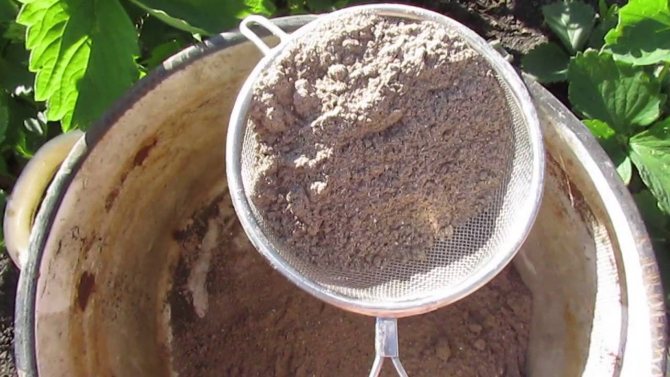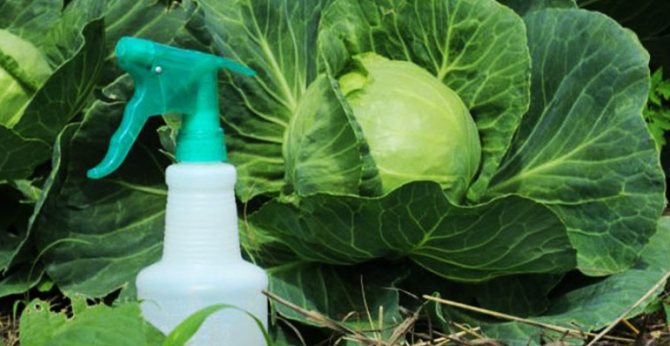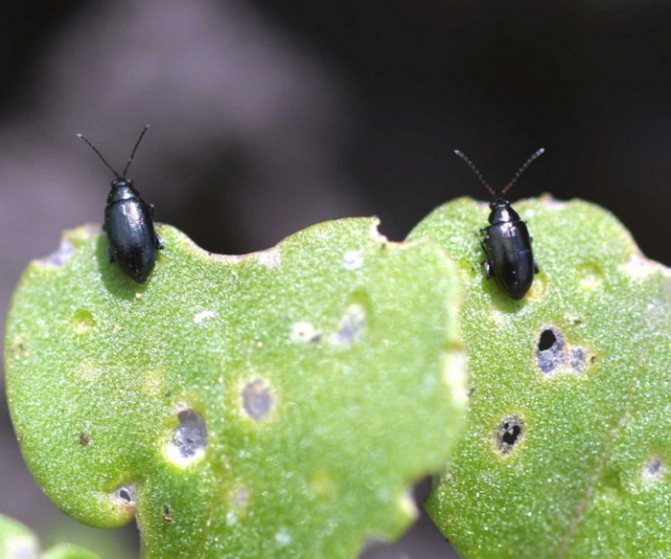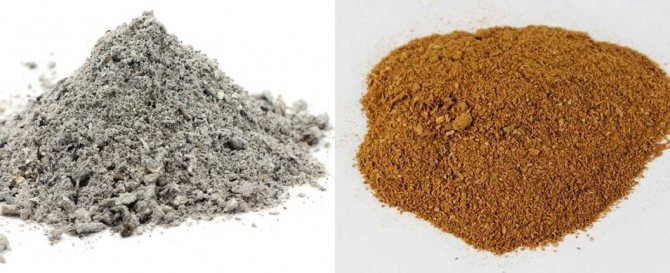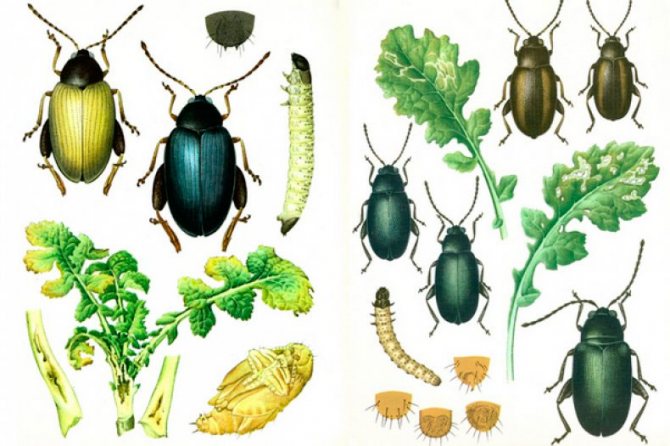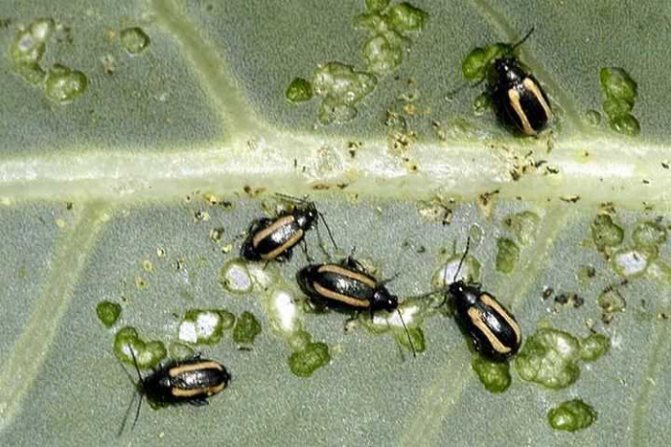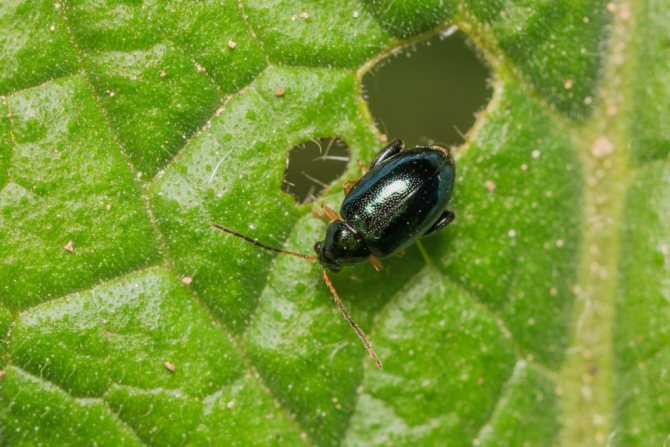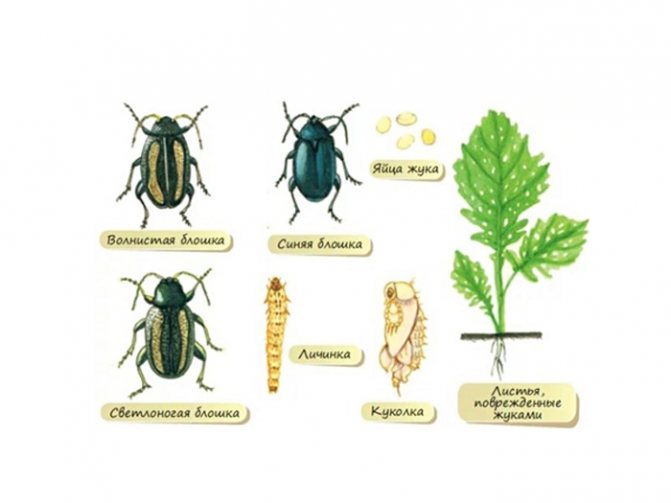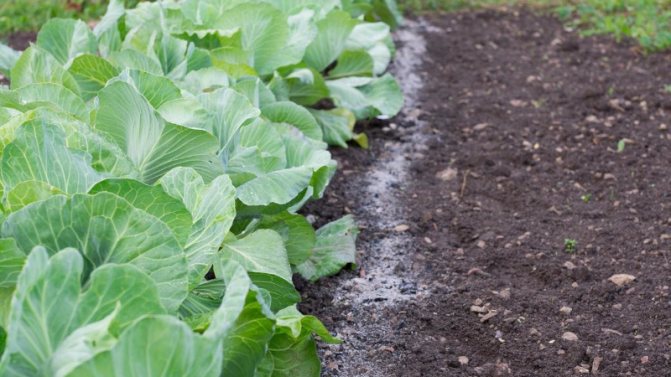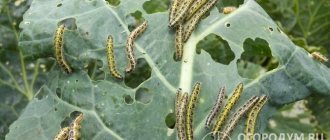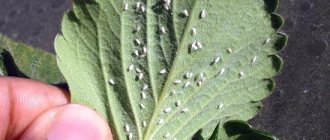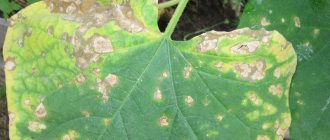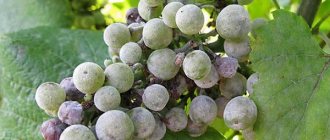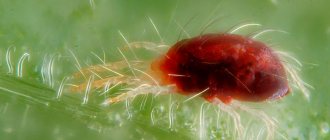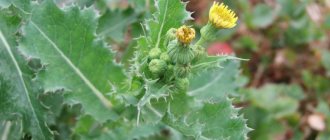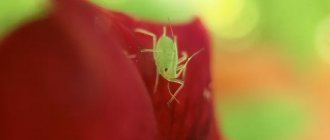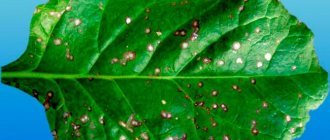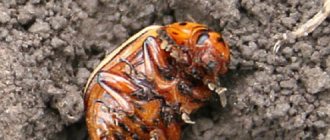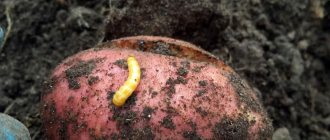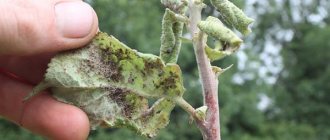The term "earthen fleas" refers to several insects that are very different from each other: in one case, they say so about ordinary fleas that live in basements or the upper layer of the soil, and in the other - about herbivorous insects. Cruciferous fleas belong to the latter species.
Cruciferous fleas belong to the family of leaf beetles. Despite this name, they have nothing to do with the usual fleas in our understanding (blood-sucking insects), these parasites are closer to the Colorado beetles and ladybirds.
Then why were they called fleas? It's simple: because of the structural features. Like ordinary fleas, they have thickened hind limbs, thanks to which insects are able to jump great distances.
What do cruciferous fleas look like? How do they differ from ordinary fleas?
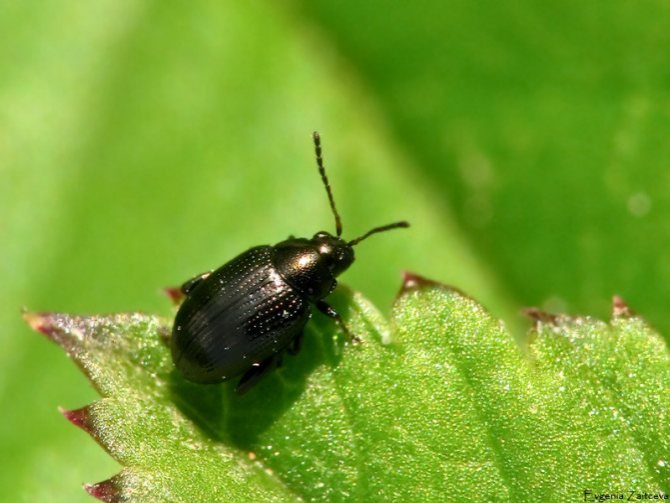
Cruciferous flea, photo In appearance, cruciferous fleas are similar to any representative of the order of coleoptera: they have dense shiny wings, three pairs of legs and antennae.
Fleas have a body about 3-4 cm in size slightly flattened on the sides. The color of insects can be different: often it corresponds to the shade of the foliage where they live. If the leaves are light green, then the color of the cruciferous flea beetle is turquoise or straw, and dark green, brown or black insects can be seen on dark leaves.
Insect description
Types of cruciferous flea beetles
The following types of cruciferous pests are distinguished:
- black are distinguished by a metallic sheen and have a size of up to 3.0 mm;
- light-legged ones are distinguished by the yellow color of the legs, a metallic shade in the head and front of the back, the size of the insect is 3.5 mm;
- blue - one-color beetles with a greenish tint and black antennae, size - 2.8 mm;
- wavy ones are distinguished by a bright yellow stripe located on the wing covers, in black and up to 2.5 mm in size;
- notched, up to 2.5 mm in size, have yellow stripes on the wing flaps, while the black stripe narrows both at the back and at the front.
Reproduction of the cruciferous flea
The oblong eggs that beetles lay are translucent light yellow in color. The size of the pest is 0.4 mm.
The insect larva outwardly resembles a 4 mm light yellow worm with three pairs of legs.
What does the insect eat
When the first vegetation appears, cruciferous fleas go out in search of food. Cruciferous plants are the first to suffer from the pest.in which beetles eat cultivated plants. Fleas eat up leaf tissue or leave sores on them in large numbers. In most cases, beetles damage:
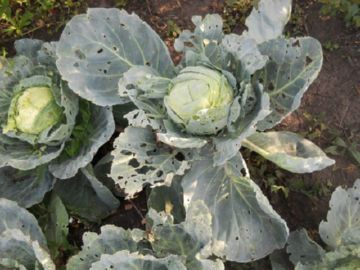

- radish. It is mainly young shoots that suffer - small holes appear on the leaves; strawberries. Pests eat pits on leaves, and sometimes on berries;
- cabbage. Parenchyma in the form of dimples remains on its leaves from pests;
- rape. First, the beetles gnaw through holes and open notches along the edges of the leaves, then they eat it completely, that is, only the veins remain intact.
On warm and clear days, their activity is especially noticeable: the number of injuries increases. Seedlings can be ruined in three or four days if measures are not taken in time. Until the seedlings appear, beetles consume weeds - rape, shepherd's purse and other plants belonging to the Cabbage family.
Breeding period
A new generation of flea beetles appears in the height of summer and hibernates in the upper soil layer, as well as in plant debris. The development of the larvae and their life takes place at the root of the plant and in the ground, where they do not particularly harm. The exception is the light-footed flea, whose caterpillars destroy the leaves, making many holes in them.
The larva develops for 2–4 weeks, and the transformation into a pupa occurs by the end of July. Black, wavy, blue and light-footed fleas are more harmful than other species. Radish, turnip, cabbage, radish and watercress are plants that kill beetles. Insects have spread throughout Russia, except for the territory of the Far North.
Folk remedies
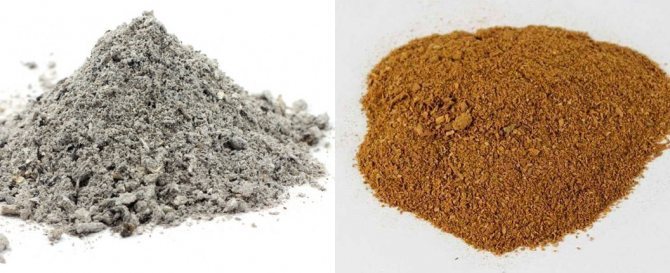

Vegetable crops affected by the cruciferous flea are recommended to be sprayed with chemicals only as a last resort, because they contain poisons that are dangerous to both humans and beneficial insects. Instead of chemistry, experienced gardeners advise using folk remedies that are not only safe, but also quite effective.
Most often, summer residents use the following effective folk remedies in the fight against a pest:
- Seedlings immediately after transplanting into open ground must be powdered with wood ash; you can also use tobacco dust combined with ash (1: 1) for this. Pollination is carried out on a fine, windless day, while there should be no rain in the near future after treatment. This procedure is carried out three times with a break of 4 or 5 days. After pollination on all leaves, both surfaces should be covered with the composition.
- Vegetables should be sprayed with a decoction made from tomato tops: combine 2 kg of dry or 4 kg of fresh tops with a bucket of cold water, wait four hours and boil the mixture over low heat for 30 minutes. The cooled and strained broth is combined with water in a 1: 1 ratio and with grated or liquid soap, taken in an amount of 40 grams. The composition of the bushes is treated three times with a break of three or four days.
- Pass 1 tbsp through a meat grinder. garlic and the same amount of tomato tops. The resulting mass is poured with a bucket of lukewarm water. Mix everything well and strain. One large spoonful of liquid soap is poured into the resulting product, after which the bushes are sprayed with the resulting product.
- 500 g of dandelion roots and foliage are combined with a bucket of water, do not forget to grind them first. Stir well and strain. Pour some liquid soap into it before processing.
- A bucket of water is combined with a pair of glasses of wood ash. The mixture should be infused for two days, after which it is carefully drained and ¼ part of a bar of tar soap is dissolved in the resulting product, which is previously ground on a grater.
- 10 liters of hot water is combined with 0.2 kg of tobacco dust. The cooled and strained infusion is combined with one large spoonful of dishwashing liquid or liquid soap.
- 10 liters of water are combined with 2 large spoons of vinegar essence or 1 tbsp. vinegar (9%). Spray the foliage with a well-mixed solution.
- A couple of liters of water are combined with 1 kg of finely chopped wormwood. The mixture is boiled over low heat for 10-15 minutes. The cooled broth is mixed with 100 grams of chopped garlic and filtered. The volume of the resulting product is brought up to 10 liters with clean water.
- 5 liters of water are combined with 2 kilograms of potato tops and boiled over low heat for half an hour. The cooled broth is filtered and diluted in half with water. Processing is carried out in the evening.
- Prepare an infusion of chicken manure in a ratio of 1:20. It is kept in the open air for seven days, after which it is filtered and you can start processing. This infusion will not only scare off flea beetles, but also become a source of nitrogen for plants.
- Combine half a bucket of water with one tablespoon of flea repellent (available at the pet store). The resulting solution is sprayed with bushes.
- A flag is made of cardboard or thin plywood, both surfaces of which are covered with solid oil or resin. Walk several times along the rows of plants, on which fleas have settled, do not forget to wave the flag and touch the foliage with it. Frightened pests will start jumping, and most of them will stick to the flag.
- Take a few pieces of cloth and soak them in used car oil or diesel oil. Distribute them on sheets of cardboard in the aisles of the beds, while the distance between them should be about four meters. After two or three days, you need to turn the fabric over to the other side, thanks to which it will be possible to collect a lot more pests.
Effective methods of dealing with cruciferous flea beetles
Many ways have been invented to eliminate this scourge.
Chemical ones are more effective, but folk ones are safe. Each gardener chooses the one that suits him best.
Agrotechnical techniques
It is easier to prevent any trouble than to deal with it.
Cruciferous fleas are no exception, methods of dealing with which begin with prevention. Otherwise, it can be called agrotechnical measures.
When the bugs begin to show activity, there are still no cultivated plants suitable for food.
If there are no wild cruciferous plants, then these pests will simply have nothing to eat in your garden.


Weeds removed from the garden
Therefore, weed-free beds are one of the best ways to prevent harmful bugs from appearing.
There are other agrotechnical methods:
- dig up the beds before winter in order to destroy hibernating pests;
- plant seedlings and other damaged plants together with phytoncides - marigolds, calendula, garlic, dill and coriander;
- flea beetles do not like wet leaves - therefore, regular watering is required;
- in order for the plants to get stronger faster, they need to be fed in a timely manner, the flea beetles will not like the tough leaves;
- a very effective way is to hide the plants under a non-woven covering material, in this case the pests simply cannot reach them.
Often it is not possible to do with prevention alone. Crops such as cabbage and radish are sown early. How to protect radishes from cruciferous fleas?
This vegetable is early ripening. Chemicals simply do not have time to decompose. And no one wants to eat poisonous roots. Popular methods will come to the rescue.
Folk ways
All popular methods of dealing with cruciferous flea beetles can be divided into dry and wet.
In the first case, leaves wet after dew or watering are powdered with dry mixtures in a 1: 1 ratio.
- Wood ash and fluff lime.
- Tobacco dust and ash.
- Ash and road dust.
Along the way, you can pollinate the aisles, but with stronger means.
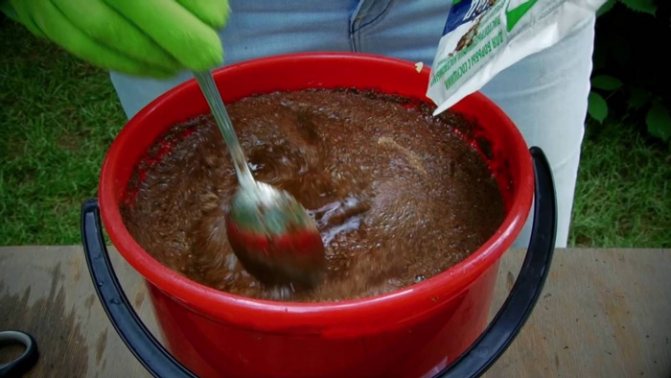

Tobacco dust diluted in water
Tobacco dust or naphthalene will do.
Pests eat delicate lettuce leaves with great pleasure. How to discourage them, how to sprinkle a salad from a cruciferous flea?
Many infusions and decoctions are used for spraying, they make the leaves tasteless for pests.
- Ash is diluted with boiling water in a ratio of 1: 3. Insist 48 hours. Spray with soapy water.
- The crushed or minced parts of the dandelion are infused in water. 10 liters will require 0.5 kg of herbs and roots. The strained infusion is added liquid soap before spraying, art is enough. spoons.
- 200g of tobacco crumbs are poured into a bucket of hot water. When it cools down, filter and add soap.
- A glass of 9% vinegar or 2 tbsp. Is poured into a ten-liter bucket of water. tablespoons of vinegar essence.
Spraying is carried out if rain is not expected.
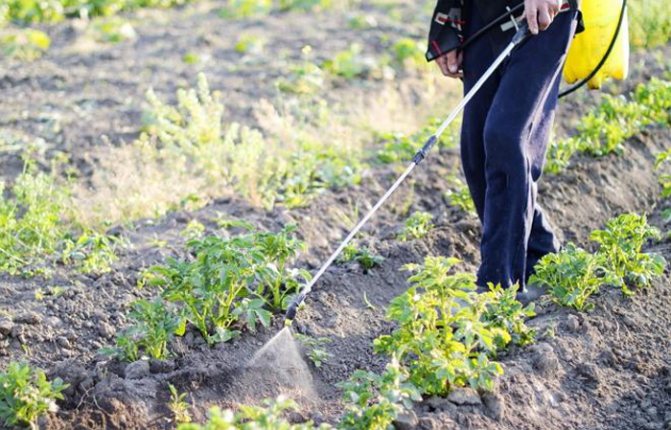

The process of spraying the beds
If a cruciferous flea attacked seedlings or seedlings, how to deal with a dangerous pest? There is a wonderful mechanical way of catching fleas, our ancestors used it.
A rectangular piece of cloth, paper or plywood is cut out and attached to the handle like a flag. Lubricate with something sticky - resin or grease.
It is enough to walk several times with such a flag over the garden bed, slightly touching the leaves, as most of the pests will be trapped in a sticky trap. This method is especially effective in the heat.
A stationary trap can also be used. To do this, pieces of fabric are moistened with used oil, diesel or automobile oil. They are laid out on the beds, placing a dense base - wood or cardboard.
For early ripening crops - radish or lettuce, folk methods of dealing with this small aggressor are the only possible ones.
For crops with a long growing season or ornamental plants, cruciferous flea treatment chemicals are available.
Chemicals
If, after all the measures taken, you can count more than 5 bugs on each plant, there is a reason to think about how to get rid of the cruciferous flea with the help of chemicals.
The range of such funds is quite extensive: from biological products Fitoverm and Aktofit, to "heavy artillery" - Decis, Intavir, Aktara, Aktellik, Fagot, Tabazol.
They should be used according to the attached instructions, not forgetting about personal protective measures. The waiting period after treatment should be strictly observed.
Before processing, it will be useful to find out the weather forecast. Do not do it before the rain. The drug will be washed off with water, since it has not yet had time to be absorbed into plant tissues. The poison will go into the soil, and the treatment will have to be repeated.
Where do cruciferous fleas live?
As mentioned, these insects are extremely hardy, they can survive in extreme temperatures. Cruciferous flea beetles can be found all over the planet.
Cruciferous fleas live in gardens and vegetable gardens, but it happens that they settle in private houses, and can also accidentally get into an apartment. In the house, beetles choose places near food, that is, near plantings and indoor plants. In a private house, they can also be seen in the upper layer of the earth: in basements or underground.
Brief characteristics of the cruciferous flea
Of all the variety of garden crops, this insect can most often be found on cabbage. Seeing a scattering of small bugs, do not postpone their destruction until later. Otherwise, it threatens your harvest, and in a total form.
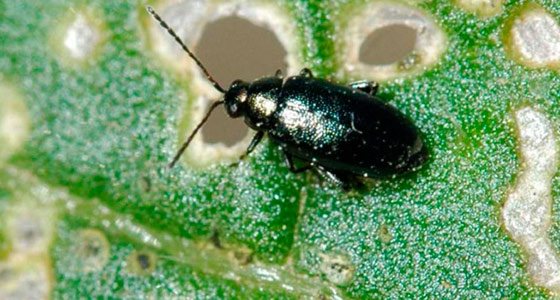

What do cruciferous fleas look like? It is an unremarkable beetle with a shiny black back about three millimeters in diameter. Like all insects of this species, they have increased jumping ability. If you look closely at the photo, it will not be difficult to recognize the flea.
They wait out the winter colds, burying themselves in fallen leaves or in the topsoil. They can also hide in the cracks in the wooden frame of the greenhouse. They wake up in the spring when the soil warms up. Since the vegetable gardens at this time are still empty, their diet is weeds belonging to this family. But one has only to ascend the first garden seedlings, fleas immediately move to it.
Control methods
To avoid insect infestation, prophylaxis should be carried out. In autumn, the soil is dug up so that the wintering beetles are on the surface and die when frost sets in. In the spring, you need to minimize the appearance of weeds of the cabbage family. From them, the cruciferous flea will move to the appeared cultivated plants. To repel insects, you can plant dill, coriander, tomatoes and potatoes around the beds. And also flowers: calendula, marigolds, nasturtium. These plants release substances into the air that beetles do not like.
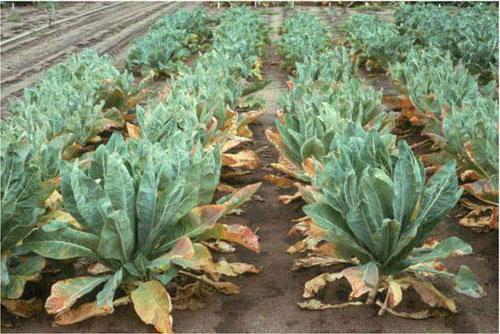

Mass breeding occurs in hot weather. At this time, young plantings are covered with a special material.It freely passes light, air and water, but interferes with the life of the flea. If insects do appear, then you will have to use other methods. How to treat cabbage from a cruciferous flea? For this, chemicals, folk methods, infusions and decoctions of plants are used. The chemical method of pest control is the most effective, but not harmless.
Ways to fight
Many inexperienced gardeners are very concerned about the question: how to get rid of a cruciferous flea? You can try to prevent insect raids in the summer by starting to carry out prevention in the fall. To do this, it is necessary to thoroughly dig up the soil so that the bugs hiding in it for the winter hit the surface and freeze with the onset of sub-zero temperatures.
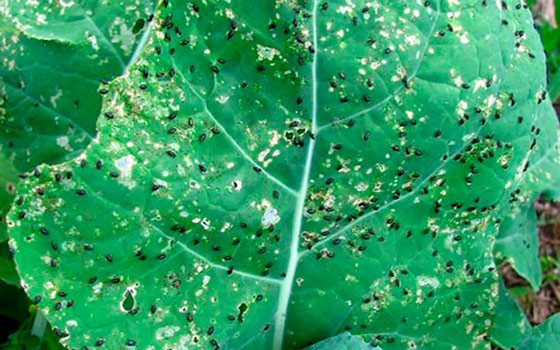

In the spring, as soon as cruciferous weeds begin to fill the beds, it is imperative not to be lazy with weeding. Otherwise, a flock of crop eaters will pounce on freshly broken vegetable sprouts.
The following plants planted near cabbage will help scare off fleas:
- vegetables: potatoes and tomatoes;
- spicy herbs: dill and coriander;
- flowers: marigolds, calendula and nasturtium.
As a result of photosynthesis, these cultures secrete special substances that this type of beetle cannot tolerate.
The bugs lay their eggs most intensively in the heat. For this period, young sprouts are wrapped in a special breathable material, which also does not interfere with the penetration of light and water, but prevents pests from multiplying. If it was not possible to avoid their appearance, then you will have to use other methods of struggle.
Effective remedies and preparations for flea beetles
There are a large number of anti-parasite chemicals on the market. The most suitable and well-proven remedies:
- Diazinon. The drug is applied on the surface of the soil in the spring when planting plants in it. After that, the soil at the landing site must be "repaired".
- "Imidalite". A composition that is more suitable for flea prevention measures. The product is used to process seeds. This is done either for some time, or immediately before placing the seeds in the ground.
- "Decis". The drug is universal, it can be used against almost all types of parasites of garden and garden plots. The form of action is contact-intestinal. In order to achieve maximum effectiveness of the fight, it is not necessary to use the product at a temperature not higher than 25 ° C in the shade. If this rule is not followed, protection will not be sufficient.
- Bi-58. Refers to the category of insecticides. One of the most popular remedies. It can be effectively used against gnawing and sucking garden parasites. The form of release in ampoules is a liquid state. It is sold as a concentrate that is diluted with 10 or 5 liters of water.
- "Karate". A composition that successfully copes with a large number of insect species. Plants must be sprayed during the growing season. In this case, you must follow the measures to protect your health.
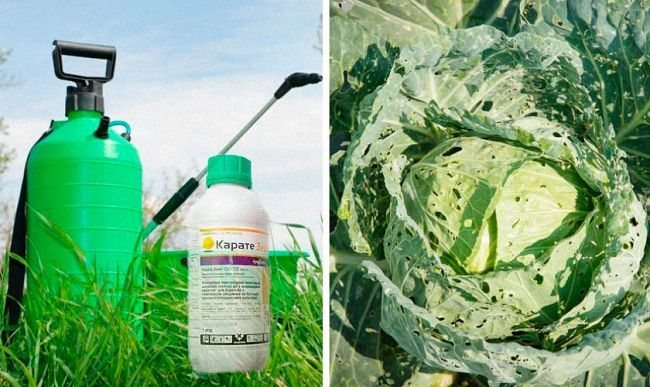

Regardless of the success of the effects of drugs, they must be used strictly at the frequency and in the dosage indicated in the instructions. Excessive use of drugs can adversely affect the condition of plants, as well as affect the human body when eating fruits.
What harm do cruciferous fleas do? Are cruciferous fleas dangerous to humans?
The cruciferous flea feeds on leaves, so it is harmless to humans. The insect does not attack either humans or animals.
But this insect cannot be called completely harmless. Since cruciferous fleas live in green spaces and feed on them, they are obviously harmful precisely because they can damage the plantings.
If a small number of these insects have started up in the garden, then there is nothing to worry about: they will not cause serious harm. If the population of cruciferous fleas is large, then because of them, you can be left without a crop.
The presence of insects is especially harmful in dry weather, since the leaves dry out quickly through the damaged parts.
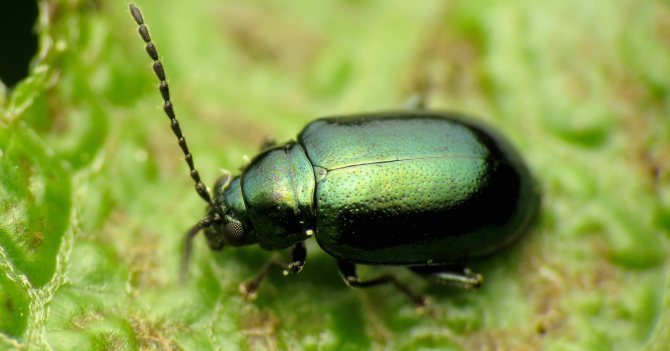

Cruciferous flea, close-up photo
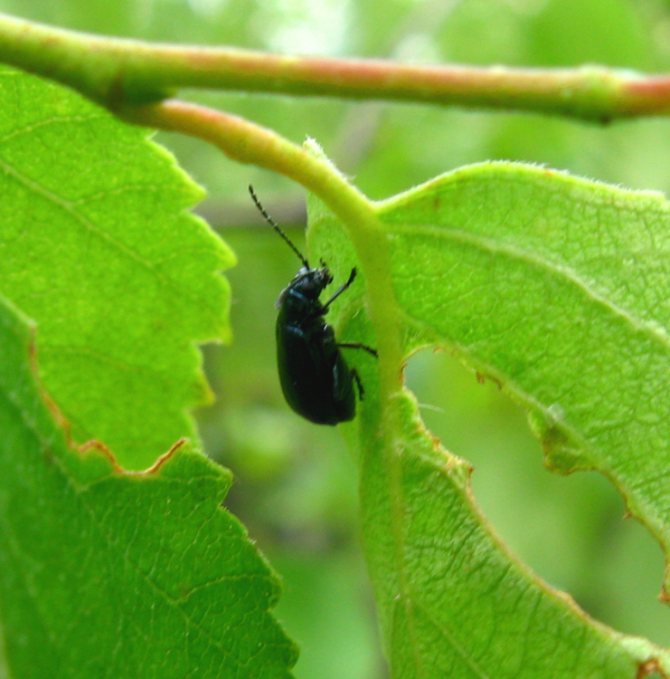

Cruciferous flea on site
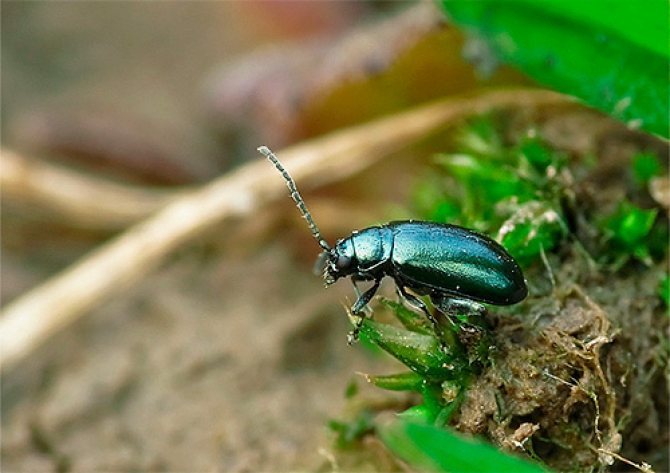

Cruciferous flea, appearance
Description of black flea beetles
Fleas are the collective name for many species that are arthropod insects. The house is usually inhabited by a human black flea. With a small size (only up to 3 cm), it has an enviable jumping ability, overcoming a distance of up to 50 cm in one jump and reaching a height of 30 cm.
Fleas are extremely hardy and can easily endure extreme cold snaps and warming. But the optimal temperature for fleas is between 18 and 26 degrees. Much more black fleas are more sensitive to air humidity: if it drops below 70%, then larvae will not appear from the eggs.
Folk recipes for getting rid of insects
A widely used folk remedy for a gluttonous flea is spraying the sprouts with a vinegar solution. Two hundred milliliters of nine percent vinegar are diluted into ten liters of water.
You can pollinate the garden with tobacco dust and wood ash, ground pepper. For the same purposes, slaked lime or naphthalene is used. True, folk remedies will only be able to scare off pests. In this regard, such manipulations are carried out repeatedly, for example, every time after watering.
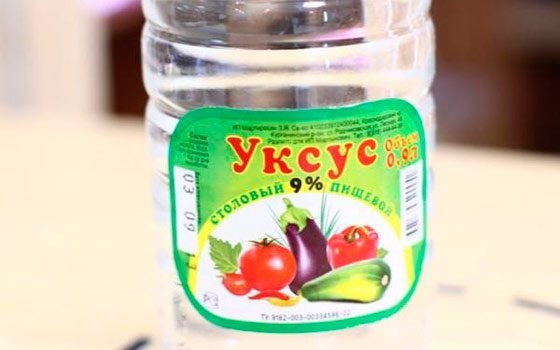

Cruciferous flea. The small beetle is a big pest.
04/04/2017 Cruciferous or cabbage flea (Phyllotreta cruciferae
) Is a tiny earthen beetle, only about two, three millimeters in size, belonging to the family of leaf beetle pests.
The name "cruciferous" beetle received as a "reward" for the fact that with pleasure it eats plants of the cruciferous family, namely cabbage, horseradish, rapeseed, radish, radish and the like.
It should be noted that, despite the nickname flea, the pest has nothing to do with fleas, although the hind legs of the beetle, like that of a flea, are jumping, which makes the insect mobile and elusive.
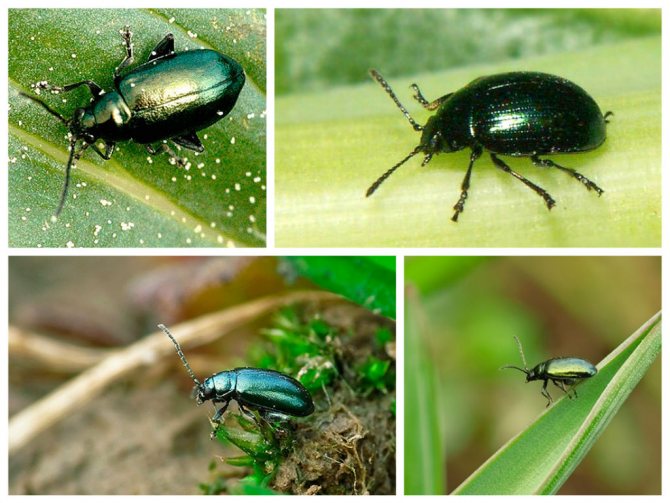

Of all the existing varieties, the following four types of beetle are most often found:
1. Wavy flea
(has a dark color with yellow longitudinal stripes on the elytra).
2. Light-footed flea
(body color is black, graphite).
3. Notched flea
(has a black color).
4. Blue, garden or earthen flea
(has a dark blue color with a greenish tint).
The leaf beetle pest manages to produce two or three offspring per season. It reproduces especially quickly in hot sunny weather. Under favorable weather conditions, the flea breeds so rapidly and massively that in just a couple of days the colony is able to destroy almost all cabbage seedlings on the site. Eagerly pouncing on young juicy greens, the pests cut and sieve the leaves like scissors, which is why they are completely covered with small holes.
Damage to the leaf blades ultimately leads to drying and death of sprouts or seedlings.
The leaf beetle hibernates in the surface layer of the soil, under the carrion and wakes up only with the arrival of spring.
As soon as the ground warms up and thaws, which usually happens in April-May, and the air temperature rises to fifteen degrees Celsius, adults come to the surface and begin migration in search of food. During this period, the beetles feed on common weeds (preferring wild plants of the cruciferous family) and their diet is dominated by the leaves of the rape, the bark of the field, shepherd's purse. With the advent of cultivated plants, the beetle almost completely switches to them.
Flea eggs
In May-June, females begin an active mating process and lay eggs directly on the leaves of the cruciferous family. The eggs of the pest are very small, translucent, slightly oblong and have a light yellow tint.
After about a week, mobile and voracious larvae appear from them.
Flea larvae
After leaving the egg, the beetle larva immediately bites into the leaf and begins to feed on its juicy pulp. Her body is elongated, light yellow in color.
The transformation of the larva into a pupa occurs already underground, for which the larva leaves the plant and goes into the soil to a depth of ten centimeters, where it pupates.
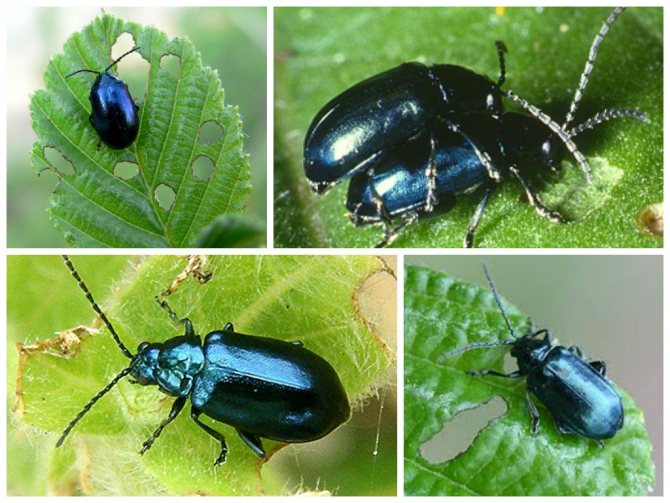

Soon a beetle emerges from it.
Flea imago
After emerging from the pupa and turning into an adult insect, the young beetle stays in the soil for two to three days, and then comes to the surface. Under unfavorable conditions (for example, with a sharp drop in air temperature), the exit process can be delayed.
Flea fighting
Physical control of the cruciferous flea is difficult due to its small size and high jumping ability of the insect.
Agrotechnical methods of struggle
First of all, since the flea hibernates in plant debris and carrion, therefore, immediately after harvesting, it is necessary to thoroughly clean the entire plantation, and after cleaning, deep digging or plowing the soil.
The flea settles down for the winter, being in the upper layer of the earth, therefore, when it gets on an open surface, it dies during the first frost.
In early spring, in order to effectively control the flea, it is necessary to regularly destroy weeds on the site, and especially weeds of the cruciferous family. This method will prevent the massive appearance of the pest, because, left without a food base, the flea colony will be forced to leave the site.
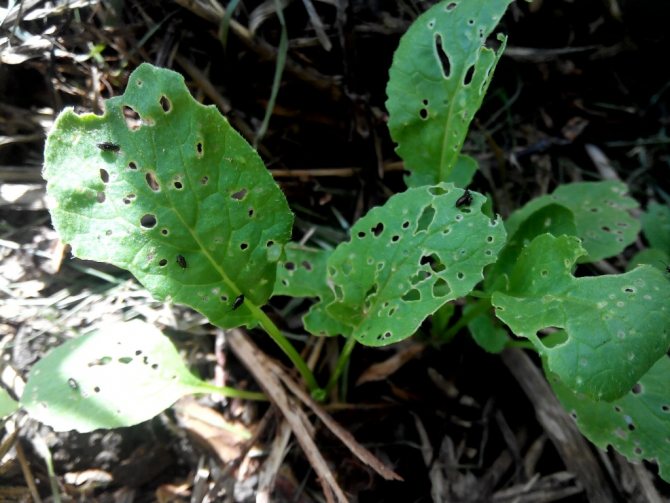

It is necessary to regularly carry out weeding or deep digging of the soil. If weeding is difficult, then it is necessary to use herbicides, but in any case, farmers need to remember that the number of weeds is directly proportional to the number of pests on the plantation.
It is important that the seedlings of cultivated cruciferous plants are strong, friendly, hardy and grow quickly, therefore, timely feeding of seedlings and young shoots is necessary. For this purpose, saltpeter is used, organic fertilizers are used, and regular watering is carried out, followed by loosening of the soil.
Another agrotechnical way of dealing with a flea (for radish, radish and daikon) is the spring, as early as possible sowing cruciferous seeds, while the pest is still in the ground. Thanks to this simple technique, early crops have time to both grow and get stronger.
Some farms follow the opposite path, that is, they use a method in which crucifers are sown as late as possible (usually in June or even July), when the flea is no longer as dangerous as in spring.
Many experts recommend planting cruciferous crops next to plants that are rich in flavor. It has long been noted that plants with a strong odor such as dill, caraway seeds, garlic, calendula and similar phytoncides effectively repel the pest.
Chemical methods
As a rule, chemical preparations provide a high effect in eliminating parasites, but they are unsafe, since they contain harmful components, therefore, they should be used only in exceptional cases.
In addition, when working with chemical control agents, you need to be very careful, accurate and be sure to first read the instructions for their use or contact a specialist.
On household plots, Actellic is used from insecticides (at the rate of twenty milliliters per ten liters of water). The solution consumption is one liter per ten square meters of area. Other chemicals that can be recommended are "Decis", "Intavir", "Aktara", "Bankol", "Karate".
Traditional methods
Experienced gardeners have long and successfully used sprinkling of plants with wood ash, furnace soot from house pipes, fine tobacco dust for a long time and successfully used to combat the flea, or they use the spraying of young leaves of plants with ash infusion. In order to get the effect, it is necessary to process the leaves from both the upper and lower sides at least three times with an interval of four to five days.
Soot, ash and tobacco dust at the same time serve as a good additional fertilizer for seedlings.
To prepare an ash solution, you will need wood ash (if available, you can add tobacco dust to the solution) and slaked lime. All components must be mixed in equal proportions until a volume of one liter is obtained, and then dissolved in three liters of boiling water. As soon as the mixture is infused (it is advisable to set aside 48 hours for this procedure), add three tablespoons of liquid soap to it. Mix the resulting solution thoroughly. It is advisable to spray seedlings in the evening.
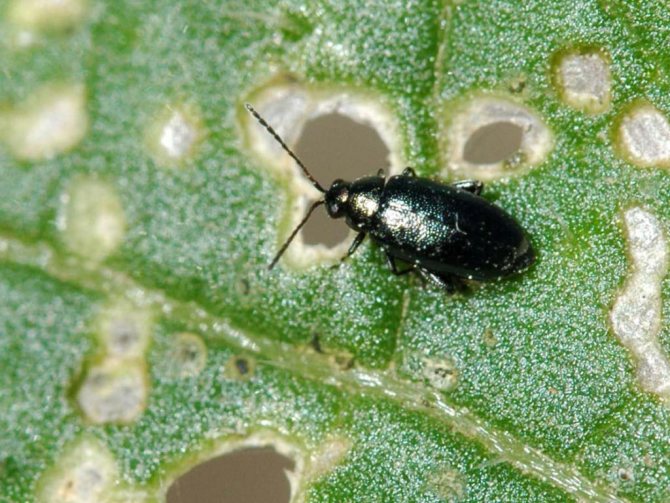

Another effective method used by many gardeners is to sprinkle crucifers with a vinegar solution (at the rate of one glass of vinegar per ten liters of water). Then you should carefully spray the sprouts of cabbage, radish, horseradish, radish, sorrel, turnip and other plants of this family.
This method is quite effective, and, moreover, it is absolutely safe for human health. Its downside is that the process will have to be repeated several times.
How to spot cruciferous fleas?
As already mentioned, beetles prefer to feed on young seedlings, so you need to carefully monitor the seedlings. Plants of the cruciferous family are most often attacked by insects, for this reason we recommend starting inspection of the plantings with them.
Due to the fact that insects merge in color with the foliage, it is rather difficult to notice them. Complicating the situation is the fact that, upon noticing a danger, cruciferous fleas immediately hide.
Signs of the appearance of cruciferous flea beetles:
- the soft part is missing on the leaves, while the veins remain;
- large uneven spots can be seen on the underside of the leaves;
- there are small holes in the stem along its entire height.
Flea is a dangerous pest
Yet the most favorite delicacy is cabbage. Action should be taken immediately if a cruciferous flea appears on cabbage. How to deal with it? The bug stands out among other insects for its jumping ability and a shiny body. The small flea is just over 3 mm in size. For the winter, beetles hide under fallen leaves, shallowly into the soil, hiding in the cracks of greenhouses and hotbeds.
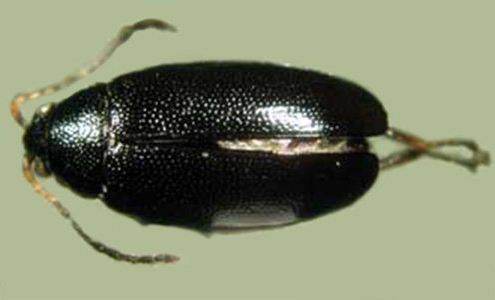

Fleas wake up as soon as the soil thaws. First, they feed on weeds of the cruciferous family - this is a shepherd's purse, a rape. As cultivated plants emerge and seedlings are planted, fleas move to cabbage, radishes and other vegetables. Large areas of garden crops are destroyed when spring, sunny and hot weather sets in. At this time, fleas are able to eat all cabbage seedlings and seedlings of other plants.
Plants helpers
How to treat cabbage from a cruciferous flea using herbal preparations? Spraying bugs scares off with solutions with the addition of infusions of ground garlic, dandelion leaves, green wormwood herb.
You can spray the planting with the following warm composition: add one glass of ground garlic and tomato tops to 10 liters of water. Before using the solution, insist a little, strain and add soap for adhesion. Instead of tomato tops, you can use bitter wormwood.
Fleas have a negative attitude towards plants of the Solanaceae family. Therefore, decoctions from tomato or potato tops are used. Grind 2 kg of fresh tomato plants, add half a bucket of water and infuse for 3 hours.
As a raw material for the broth, you can try the leaves and green shells (100 g) of walnuts. Raw materials are boiled in 2 liters of water for 5-7 minutes. To 10 liters of water, add 300 g of the resulting broth.
It is worth trying and preserving the harvest, in which so much labor of love and precious time has been invested.
Cruciferous fleas: how to get rid of them? Ways to fight
To protect your plantings from insects, you need to carry out a set of measures:
- uproot weeds in a timely manner;
- grow protective repellent plants;
- grow crops in different parts of the site every season;
- reduce the number of cruciferous plants;
- water the plants on time, prevent them from drying out;
- check plants for parasites and, if necessary, fight them;
- treat plants with insecticides for preventive purposes.
Beetles can enter the house through contaminated soil or purchased plants. Before buying, carefully check the product, if there are signs of infection, then, obviously, you should refuse to purchase it.
Preparations for the fight against cruciferous flea beetles
Popular remedies are Antizhuk, Regent, Aktara and Gaucho. The products are sold dry, in bags. They need to be mixed with water and sprayed on damaged plants.
You can also find preparations in the form of ready-made aerosols, for example, "Raptor", "Raid". They also need to spray infected plantings. Aerosols are especially useful when cruciferous flea beetles appear in the house.
We recommend changing the preparations every year, since insects gradually develop immunity to them.
Basement flea remedies
An integrated approach in the fight against basement fleas, the use of modern, proven and professional insecticides is the most effective way to quickly and permanently get rid of annoying parasites.
Basement flea chemicals
Basement flea chemicals are widely used as a method of killing insects. They are represented by professional drugs that are used by pest control companies, and household solutions, aerosols, sprays.
For self-processing of an apartment, you should use chemicals that are not capable of harming humans and warm-blooded animals. The following effective insecticides can be found in specialized stores:
- "Delta zone" - causes the rapid death of insects, has a prolonged effect. The main active ingredient is deltamethrin, which paralyzes the nervous system.
- Raptor is an insecticide that is suitable for the treatment of residential premises.
- "Get" is a preparation in the form of an aerosol with peritroid, which has a detrimental effect on the nervous system of insects.
- Dichlorvos will help in the initial stages of the fight, when the number of parasites has not reached high values.
- Cucaracha is a toxic solution against earthen fleas.
- "Executioner" is an insecticide against bedbugs and land fleas.
- "Battering ram" is a substance that has a detrimental effect on most insects. The key advantage is that it destroys not only adults, but also larvae and eggs.
- "Clean House" - a product for living quarters. The main active ingredient is dust, which has long been used in the fight against parasites and harmful insects. It should be remembered that it is also dangerous for dogs, cats and other warm-blooded animals.
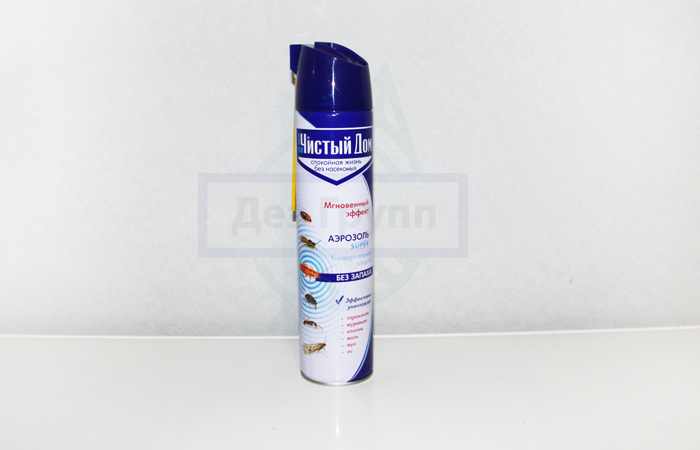

Most insecticides come in aerosol form. They are simple and easy to use. When using them, it is important to observe safety precautions and follow some rules:
- the treatment of the room is carried out in gloves and a mask that protects the respiratory system;
- remove all food from the room before spraying the chemical;
- there should be no strangers, children and pets in the apartment.
Before starting work, you should carefully study the manufacturer's instructions. In most cases, before spraying a toxic component, it is necessary to close all windows and doors, and after processing, leave the room for at least 60-80 minutes. After the expiration of time, it is necessary to carry out a thorough general wet cleaning of the apartment.
To reduce the likelihood of the reappearance of basement fleas, the destruction of all blood-sucking individuals, disinfestation should be carried out 3-5 times with an interval of 7-10 days. This will allow you to cope not only with adult insects, but also with newborn larvae.
Folk remedies for basement fleas
Folk remedies for basement fleas involve the use of improvised household preparations, aromatic plants and herbs.They are less effective than insecticides and are more suitable as deterrent and preventative measures. Traditional methods of struggle will help eliminate single individuals, but will not eliminate the problem when the number of basement fleas has reached a critical limit. The most popular insect control methods:
- Ignition in the basement of a sulfur bomb, which, with poisonous smoke and the generated heat, forces fleas to leave the room. An additional advantage of this method is the destruction of bacteria and fungi, protection from rodents. All doors and windows are closed while the object is being processed. When the smoke dissipates, covers all surfaces, the basement is ventilated.
- Plants with a pungent aroma are able to scare off blood-sucking insects and protect them from their reappearance. For these purposes, use lavender, mint, lemon balm, tansy and immortelle.
- Basement fleas try to avoid rooms that have been treated with a soapy saline solution. A concentrate of yeast and minced garlic also gives a similar effect.
An effective method of prevention is periodic treatment of the object with ultraviolet radiation. You can use portable lamps for this.
Important.
Folk remedies are a good option for prevention and creating a protective barrier. But they are not able to destroy the basement fleas, which have already chosen the room and laid eggs in it.
Chemical substances
Attacking the jumping beetle with chemicals is the last thing, since not all insecticides are harmless. The most commonly used drugs are listed below:
- Actellik;
- Inta-vira;
- Bankcol.
A novice summer resident is faced with a difficult question: which of the following to process his plantings?
Many people advise Bankcol, which is based on a biological substance obtained from marine worms.
Chemical mixtures are recommended in the fight against flea that live on cabbage, since the processing must be done twenty days before harvest. But what about the jumpers destroying radishes or lettuce leaves? After all, these vegetables ripen very early.
Chemicals
If it is absolutely necessary to treat the plantings with insecticides, it is worth choosing the most harmless of them. Since early vegetables, such as salad, radishes are used as food already at the beginning of summer. And chemical control agents are used no later than 20 days before harvesting vegetables. The most commonly used drugs for cruciferous flea beetles are "Bankol", "Actellik", "Inta-vira" and others. The drug "Bankol" is a biologically active agent. Its base is a substance made from marine annelids.
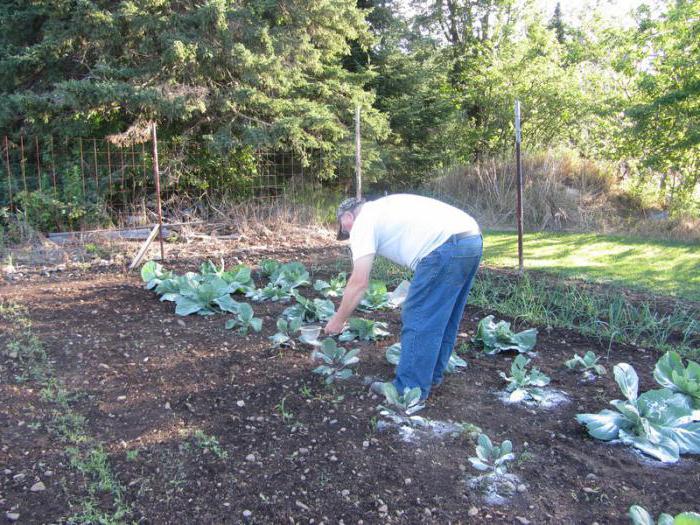

All chemical solutions are prepared immediately before use, strictly following the instructions. Spraying is carried out in the evening in calm weather, in compliance with safety measures. Chemicals should only be used as a last resort. 20 days before harvesting, a cruciferous flea on cabbage can be treated (with chemicals). How to deal with insects eating radishes, early cabbage or lettuce? After all, these are early ripening vegetables.

